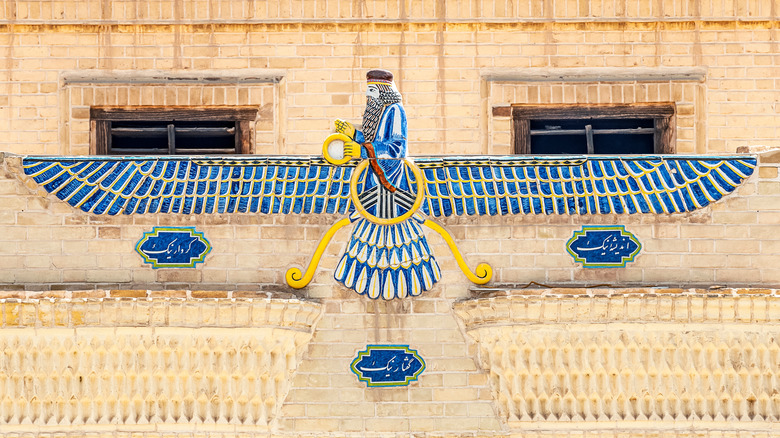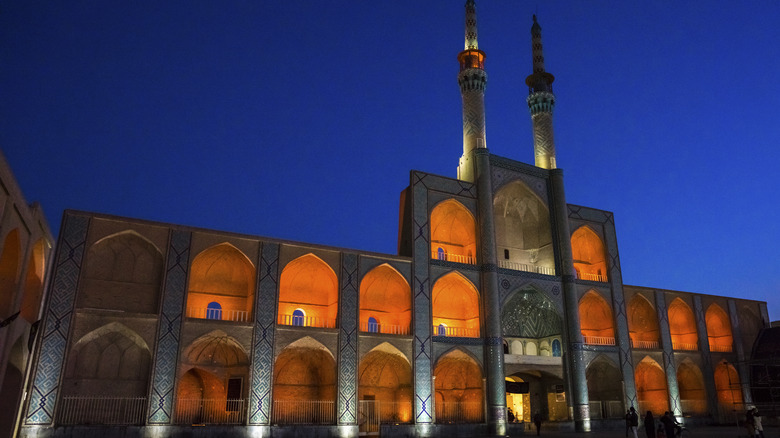What Is Zoroastrianism And What Do Followers Believe?
Historically speaking, monotheistic religions are the new kids on the block. Amongst humanity, the earliest form of anything "religious" — but without codified, universal belief systems or big, fat rulebooks — would be sympathetic magic circa 20,000 to 15,000 B.C.E., per Learn Religions. Think, "I've got the magic stick, so I'm the magic man who knows the ways of beasts," and you understand where all religion comes from. It took quite a long time for intricate tales of gods, heroes, villains, etc., to develop, like those of the Indian subcontinent or in ancient Greece. Folks often think of Judaism as the world's oldest one-god religion. Judaism is typically thought to date back nearly 4,000 years ago, but possibly only solidified as recently as a couple hundred years before Jesus' birth, per Smithsonian Magazine. But in reality, there's an older, even more ancient monotheistic religion that still exists: Zoroastrianism.
The basics of Zoroastrianism resemble other faiths, as the Yasna, a core Zoroastrian text, outlines. There's one, big good God that made people (Ahura Mazda, in this case), offerings and worship, talk of righteousness and wickedness, devils that seek to thwart people, an important prophet (Zarathustra), a proper order to the cosmos (Asha), and so forth. It's all pretty familiar in its overall facets if not its specific rituals. That's because, as History says, historians believe that Zoroastrianism influenced Judaism during the 6th-century B.C.E. Jewish Babylonian Exile. Zoroastrianism took root in modern-day Iran, impacted nearby peoples, and even spread to India and Pakistan.
Thus spake Zarathustra
The website History dates the origins of Zoroastrianism to about 4,000 years ago, and the British Library 3,500 years ago. Such numbers use written, historical records, though, and don't consider the long, long oral tradition that eventually resulted in folks writing their beliefs down. On that note, the Theosophical Society of America says that the ancient Greeks dated the life of Zoroastrianism's central figure, the god-protected prophet Zarathustra, to 6,350 B.C.E. And if the name Zarathustra rings a bell, yes, late 19th-century übermensch-loving German philosopher Friedrich Nietzsche named one of his most widely-regarded works after the prophet, "Thus Spake Zarathustra." German composer Richard Strauss, inspired by Nietzche's book, then wrote an ultra-famous tone poem, "Also Sprach Zarathustra." Trust us, you've heard it — especially if you've seen Stanley Kubrick's "2001: A Space Odyssey."
Like the Hebrew and Christian Bibles, Zoroastrianism's holy texts comprise an assortment of writings from various sources over a long span of time. Out of these, the Avesta is the most crucial. The most critical part of the Avesta, as mentioned, is the Yesna, a 72-hymn set of songs interwoven with religious rituals. The Yesna describes pouring libations to Ahura Mazda, animal sacrifices, fights with a Dragon (capital D) "belching forth his poison," supplications for protection, quotes from Zarathustra, and talk of stars and fire. It's more of an expressive poetic text than a stringent doctrinal text. And as History says, fire is key. Ahura Mazda is associated with the sun, and fire purity.
Divine revelations from Ahura Mazda
We mentioned that followers of Zoroastrianism eventually migrated to India and Pakistan, but the British Library says that they likely came from there, too. Looking at a global map, you can see how northwest India, Pakistan, and Iran blend together along the coast of the Gulf of Oman. And indeed, the British Library says that Zoroastrianism seems to have originated in tribes of polytheistic, nomadic herders traveling throughout the region. And so, Zoroastrianism also shares a common heritage with Hinduism, which originated on the Indian subcontinent and saw its oral traditions committed to written, poetic form in the Vedas between 1,500 and 500 B.C.E.
There's some disagreement on the origins of Zoroastrianism's founder, Zarathustra. History says that he might have been born in modern-day Afghanistan or Iran. Hindu Website gets more specific and places his potential birthplace outside of Tehran in Iran's north near the Caspian Sea, and Zarathustra himself as a member of a noble family. Either way, we come to a familiar point in the development of religious institutions: divine visions. Ahura Mazda, the one true God, revealed truths to Zarathustra, who set about preaching to folks in the countryside. And for those thinking this sounds like the Jesus story, Zarathustra also did this at age 30 — he was even later tempted by Angra Mainyu, or Angry Spirit. And in order to not alienate the locals, Zarathustra didn't denounce their own gods. He just said that Ahura Mazda was the chief creator.
The Asha of the cosmos
Beyond general beliefs about a dualistic, good vs. evil universe, specifics about Zoroastrianism can get very complicated, very fast. A quick glance at the Zoroastrian Archives reveals a gobsmackingly dense array of religious texts. Some of these texts were written in different languages because, as the British Library tells us, Zoroastrianism intermingled with successive empires in the Middle East.
Zoroastrianism was the dominant religion of the Persian Empire founded by Cyrus the Great in 550 B.C.E. in modern-day Iran. Cyrus is the ruler who ended the Jewish Babylonian Exile, which contributed to the cross-pollination between Zoroastrianism and Judaism, and then Christianity. Alexander the Great conquered the Persian Empire in 330 B.C.E., and his empire gave way to the Parthian (247 to 224 B.C.E.) and Sasanian (224 B.C.E. to 651 C.E.) dynasties. As The Collector explains, the Sasanian Empire fell to the prophet Mohammed during the 7th-century rise of Islam, which effectively killed off Zoroastrianism as a dominant world religion. Before and after its demise, Zoroastrianism evolved. The texts we're left with are the ones that survived.
As far as concrete Zoroastrian beliefs are concerned, the concept of "Asha" stands first and foremost. The Zoroastrian Educational Institute describes Asha as the law handed down by Ahura Mazda to humanity for the purpose of "self-realization and perfection." It entails adherence to precepts of right conduct, truth, justice, righteousness, etc., laid out by Ahura Mazda when he conceived of the universe and birthed it through his will.
Good thoughts, good words, good deeds
As the Zoroastrian Educational Institute says, Zoroastrianism concerns itself less with abstractions — despite containing some pretty abstract happenings in its texts — and more with action. "Right deeds" produce good for society, and that's that. Ego is an unnecessary concept. Moral relativism doesn't exist because right and wrong are universal for everyone, everywhere, always. Zarathustra concisely said, "Good thoughts, good words, and good deeds." Zoroastrianism also entails a separation between spirit and physical worlds. The two affect each other, however, and one's choices create one's fate. Acts of wrath, violence, and deceit are "strictly forbidden" — they set Asha in motion to produce one's afterlife punishment. Honesty, compassion, charity, and making good on promises are the greatest virtues. Also, Zoroastrianism doesn't discriminate based on gender, race, or ethnicity.
The British Library goes into detail about Zoroastrian stories like the "Revelation of Arda Viraf," which describes a man going to the underworld to report on the fates of the virtuous and the sinful. In "Divine Comedy"-like descriptions of eternal torments, he described the religiously lazy as being eternally eaten by "demonic animals," and a woman who hung upside with her "tongue pulled through the back of her neck" for disagreeing her husband and going against his wishes. The British Library says that the Vīdēvdād, on the other hand, discusses rules for ritual purification. It also contains three key Zoroastrian stories: the creation myth, the tale of Yima the first king, and Zarathustra's temptation by, and the defeat of, the evil spirit Angra Mainyu.
[Featured image by Rezamihandoostdar via Wikimedia Commons | Cropped and scaled | CC BY-SA 4.0 International]
The fire continues to burn
When Muslim invaders swarmed into the Sasanian Empire and took control, they didn't forcibly remove the Zoroastrians or execute them. They did, however, make life harder for them by taxing them to perform their religious rituals, per History. Most Zoroastrians capitulated and converted, but some fled to modern-day India and Pakistan. Those people are known as "Parsi" — related to the word Persian — and likely arrived in the Indian state of Gujarat from 785 to 936 C.E., right on the border next to Pakistan. In 2021, there were around 50,000 Parsi in India, per The New York Times, and less than 1,000 in Pakistan, according to Scroll. Worldwide, Harvard University says that all scattered Zoroastrian communities equal less than 200,000 people.
There are some Zoroastrians still living in Iran, which since the Islamic Revolution of 1979 hasn't exactly been the most religiously tolerant of places. In 2011 CNN said that there were between 35,000 and 90,000 Zoroastrians in Iran, many of which worshipped in secret and kept their beliefs hidden. In 2023 Tap Persia put the number at around 20,000. Many of those individuals live around Yadz, site of the world's main Zoroastrian temple, the Behram Fire Temple. As Apochi says, the flame in the Fire Temple has burned continuously for over 1,500 years despite persecution and was lit back in 470 C.E. during the Sasanian Empire. The eternal fire represents all of the elements of light in Zoroastrianism, including the creator Ahura Mazda, Zarathustra the prophet, and the goodness of righteous people.





